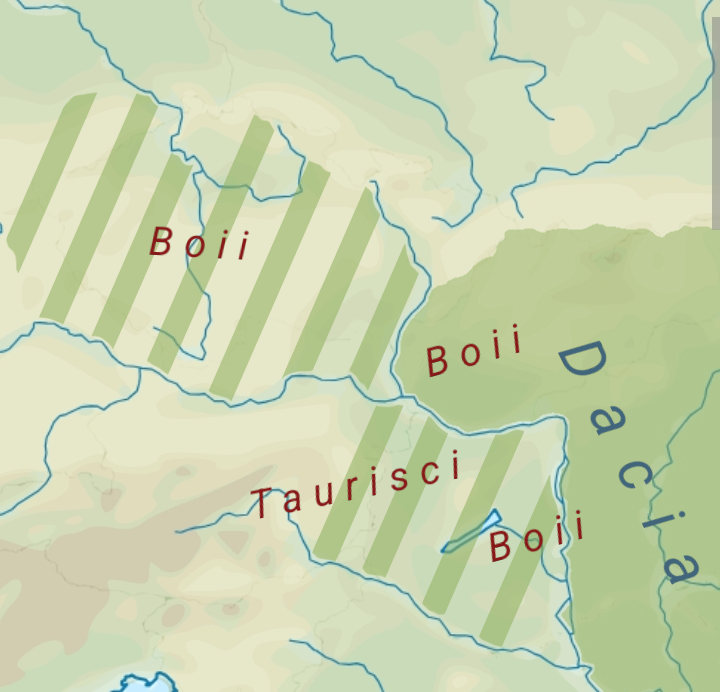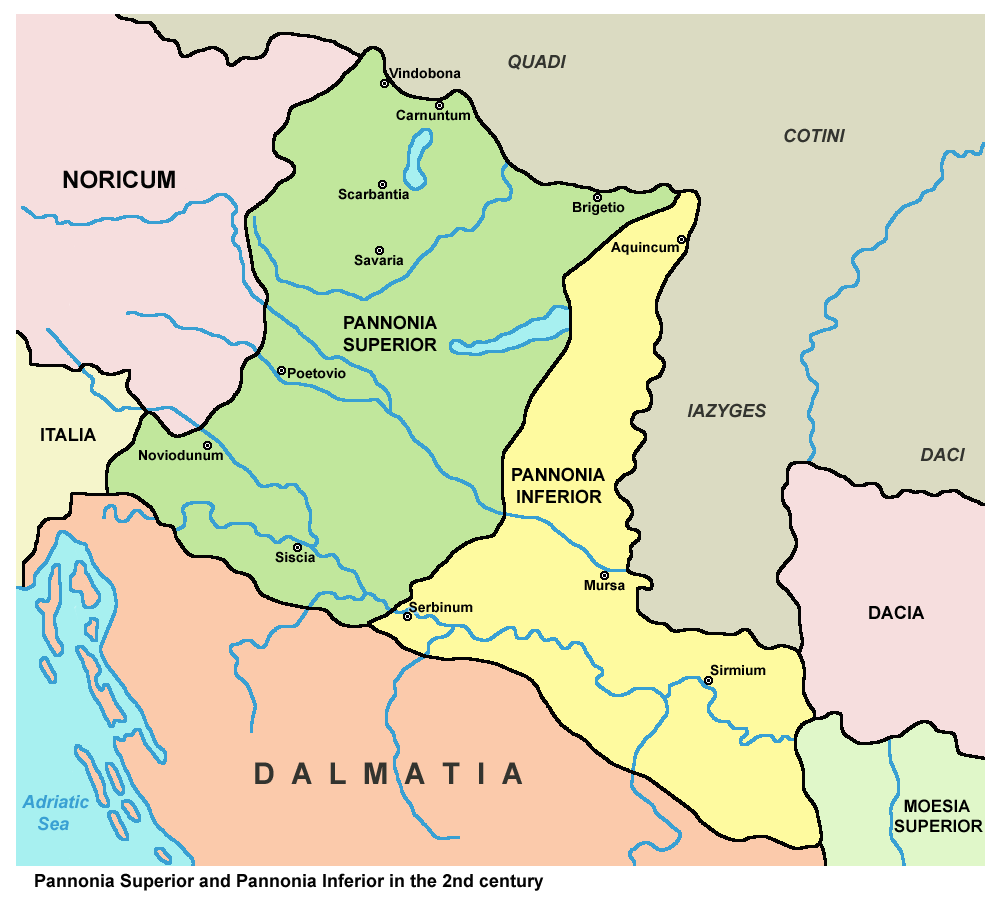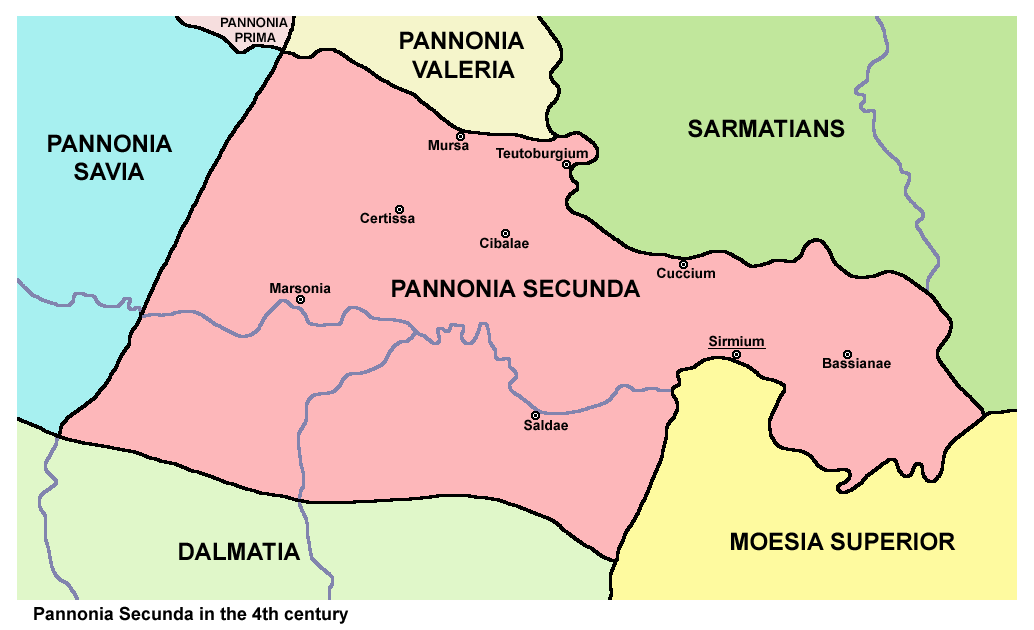|
Sirmium
Sirmium was a city in the Roman province of Pannonia, located on the Sava river, on the site of modern Sremska Mitrovica in the Vojvodina autonomous province of Serbia. First mentioned in the 4th century BC and originally inhabited by Illyrians and Celts, it was conquered by the Romans in the 1st century BC and subsequently became the capital of the Roman province of Pannonia Inferior. In 293 AD, Sirmium was proclaimed one of the four capitals of the Roman Empire. It was also the capital of the Praetorian prefecture of Illyricum and of Pannonia Secunda. The site is protected as an archaeological Site of Exceptional Importance. The modern region of Syrmia (Srem or Srijem) was named after the city. Sirmium purportedly had 100,000 inhabitants and was one of the largest cities of its time. Colin McEvedy, whose estimates for ancient cities are much lower than the general consensus, put the population at only 7,000, based on the size of the archaeological site. The amount of gra ... [...More Info...] [...Related Items...] OR: [Wikipedia] [Google] [Baidu] |
Sremska Mitrovica
Sremska Mitrovica (; sr-Cyrl, Сремска Митровица, ) is a List of cities in Serbia, city in Serbia. It is situated on the left bank of the Sava, Sava river. , the city has a total population of 36,764 inhabitants, while its administrative area has a population of 72,580 inhabitants. As Sirmium, it was a capital of the Roman Empire during the Tetrarchy of 4th century CE. Ten Roman emperors were born in or near this city, Emperors Herennius Etruscus (251), Hostilian (251), Decius, Decius Traian (249–251), Claudius Gothicus (268–270), Quintillus (270), Aurelian (270–275), Marcus Aurelius Probus, Probus (276–282), Maximian (285–310), Constantius II (337–361) and Gratian (367–383). Name The modern town name is ''Sremska Mitrovica'' (). The Hungarian language, Hungarian name was ''Szávaszentdemeter'' while in Croatian language, Croatian it is referred to as ''Srijemska Mitrovica''. In Pannonian Rusyn, it is referred to as . Mitrovica stems from Saint Deme ... [...More Info...] [...Related Items...] OR: [Wikipedia] [Google] [Baidu] |
Syrmia
Syrmia (Ekavian sh-Latn-Cyrl, Srem, Срем, separator=" / " or Ijekavian sh-Latn-Cyrl, Srijem, Сријем, label=none, separator=" / ") is a region of the southern Pannonian Plain, which lies between the Danube and Sava rivers. It is divided between Serbia and Croatia. Most of the region is flat, with the exception of the low Fruška gora mountain stretching along the Danube in its northern part. Etymology The word "Syrmia" is derived from the ancient city of Sirmium (now Sremska Mitrovica). Sirmium was a Celts, Celtic or Illyrians, Illyrian town founded in the third century BC. ''Srem'' ( sr-Cyrl, Срем) and ''Srijem'' ( sr-Cyrl, Сријем, label=none) are used to designate the region in Serbia and Croatia respectively. Other names for the region include: * Latin: ''Syrmia'' or ''Sirmium'' * Hungarian language, Hungarian: ''Szerémség'', ''Szerém'', or ''Szerémország'' * German language, German: ''Syrmien'' * Slovak language, Slovak: ''Sriem'' * Pannonian R ... [...More Info...] [...Related Items...] OR: [Wikipedia] [Google] [Baidu] |
Pannonia Secunda
Pannonia Secunda was one of the provinces of the Roman Empire. It was formed in 296 AD, during the reign of Emperor Diocletian. The capital of the province was Sirmium (today Sremska Mitrovica). Pannonia Secunda comprised parts of present-day Serbia, Croatia, and Bosnia and Herzegovina. History Prior to the establishment of this province, its territory was part of the province of Pannonia Inferior. In 296 AD, Pannonia Inferior was divided into two separate provinces: Pannonia Secunda in the south and Pannonia Valeria in the north. The River Drava served as the border between the two newly created provinces. The capital of Pannonia Secunda, Sirmium, held a prestigious status as one of the four capitals of the Roman Empire. Notably, several Roman emperors were born in or near this city, highlighting its significance in the empire's history. In 314 AD, a pivotal battle took place between two rival claimants to the imperial throne, Constantine the Great and Licinius, in the provinc ... [...More Info...] [...Related Items...] OR: [Wikipedia] [Google] [Baidu] |
Pannonia
Pannonia (, ) was a Roman province, province of the Roman Empire bounded on the north and east by the Danube, on the west by Noricum and upper Roman Italy, Italy, and on the southward by Dalmatia (Roman province), Dalmatia and upper Moesia. It included the modern regions western Hungary, western Slovakia, eastern Austria, northern Croatia, north-western Serbia, northern Slovenia, and northern Bosnia and Herzegovina. Background In the Early Iron Age, Transdanubia was inhabited by the Pannonians or Pannonii, a collection of Illyrians, Illyrian tribes. The Celts invaded in the Late Iron Age and Gallo-Roman culture, Gallo-Roman historian Pompeius Trogus writes that the Celts were met with heavy resistance from the locals and were not able to overrun the southern part of Transdanubia. Some tribes advanced as far as Delphi, with the Scordisci settling in Syrmia (279 BC) upon being forced to withdraw. The arrival of the Celts in Transdanubia disrupted the flow of amber from the Balti ... [...More Info...] [...Related Items...] OR: [Wikipedia] [Google] [Baidu] |
Pannonia Inferior
Pannonia Inferior, lit. Lower Pannonia, was a province of the Roman Empire. Its capital was Sirmium. It was one of the border provinces on the Danube. It was formed in the year 103 AD by Emperor Trajan who divided the former province of Pannonia into two parts: Pannonia Superior and Pannonia Inferior. The province included parts of present-day states of Hungary, Serbia, Croatia, and Bosnia and Herzegovina. The province was bordered to the east (across the Danube) by a Sarmatian tribe—the Iazyges. Later, the Vandals appeared to the north-east. Settlements Major settlements in Pannonia Inferior included: * ''Sirmium'' (Sremska Mitrovica) which several times served as an imperial residence for several emperors. * '' Aquincum'' (Buda), the provincial capital. * ''Cuccium'' ( Ilok) * ''Cibalae'' (Vinkovci) * ''Mursa'' ( Osijek) * ''Certissa'' ( Đakovo) * ''Marsonia'' (Slavonski Brod) * ''Sopianae'' (Pécs) Aftermath and legacy The province was yet again split during the reign of ... [...More Info...] [...Related Items...] OR: [Wikipedia] [Google] [Baidu] |
Bassianae
Bassianae or Bassiana ( Serbian: ''Basijana'' or Басијана) was an important ancient Roman town in Pannonia (today Syrmia region in Vojvodina province, Serbia). It was located near present-day Donji Petrovci, a village in the Ruma municipality. Bassianae was the second largest town in Syrmia, after Sirmium. It was located on a road that connected Sirmium and Singidunum. History Bassianae was founded as an autonomous ''civitas'' in the 1st century and existed until the 6th century. It obtained the ''municipium'' status in 124 AD, while in 214 AD it was recorded as a colony. Initially, the town was part of the province of Pannonia, but due to the subsequent divisions of this province, Bassianae was included into Pannonia Inferior (2nd century) and later into Pannonia Secunda (3rd century). It was one of the more important towns in the Pannonia province. During late Roman Empire, the town was a seat of one high official - ''procurator gynaecii Bassianensis Pannoniae secundae'' ... [...More Info...] [...Related Items...] OR: [Wikipedia] [Google] [Baidu] |
Praetorian Prefecture Of Illyricum
The praetorian prefecture of Illyricum (; , also termed simply the prefecture of Illyricum) was one of four praetorian prefectures into which the Later Roman Empire, Late Roman Empire was divided. The administrative centre of the prefecture was Sirmium (375–379), and, after 379, Thessalonica.Thessalonica 1910 Catholic Encyclopedia 1910 Catholic Encyclopedia It took its name from the older Illyricum (Roman province), province of Illyricum, which in turn was named after ancient Illyria, and in its greatest expanse encompassed Pannonia, Noricum, Crete, and most of the Balkans, Balkan peninsula except for Diocese of Thrace, Thrace. Administrative history Unlike the other three "classical" ...[...More Info...] [...Related Items...] OR: [Wikipedia] [Google] [Baidu] |
Singidunum
Singidunum ( sr-Cyrl-Latn, Сингидунум, Singidunum) was an ancient city which later evolved into modern Belgrade, the capital of Serbia. The name is of Celtic origin, going back to the time when the Celtic tribe Scordisci settled the area in the 3rd century BC, following the Gallic invasion of the Balkans. Later on, the Roman Republic conquered the area in 75 BC and incorporated it into the province of Moesia. It was an important fort of the Danubian Limes and Roman Legio IV Flavia Felix was garrisoned there since 86 AD. Singidunum was the birthplace of the Roman Emperor Jovian. It was sacked by Huns in 441, and by Avars and Slavs in 584. At the beginning of the 7th century, the Singidunum fort was finally destroyed. A large part of Belgrade's downtown belongs to the "Archaeological Site of Singidunum", which was declared a protected zone on 30 June 1964. Celtic period Origin The Scythian and Thracian-Cimmerian tribes traversed the region in 7th and 6th centur ... [...More Info...] [...Related Items...] OR: [Wikipedia] [Google] [Baidu] |
Serbia
, image_flag = Flag of Serbia.svg , national_motto = , image_coat = Coat of arms of Serbia.svg , national_anthem = () , image_map = , map_caption = Location of Serbia (green) and the claimed but uncontrolled territory of Kosovo (light green) in Europe (dark grey) , image_map2 = , capital = Belgrade , coordinates = , largest_city = capital , official_languages = Serbian language, Serbian , ethnic_groups = , ethnic_groups_year = 2022 , religion = , religion_year = 2022 , demonym = Serbs, Serbian , government_type = Unitary parliamentary republic , leader_title1 = President of Serbia, President , leader_name1 = Aleksandar Vučić , leader_title2 = Prime Minister of Serbia, Prime Minister , leader_name2 = Đuro Macut , leader_title3 = Pres ... [...More Info...] [...Related Items...] OR: [Wikipedia] [Google] [Baidu] |
Triballi
The Triballi (, ) were an ancient people who lived in northern Bulgaria in the region of Roman Oescus up to southeastern Serbia, possibly near the territory of the Morava Valley in the late Iron Age. The Triballi lived between Thracians to the east, Illyrians the west and Celts to the north and were influenced by them. As such in contemporary sources, they are variably described as an independent, Thracian, Illyrian or Celtic tribe. Strabo considered the Triballi as a Thracian people. Most ancient sources considered the Triballi as Thracians, while some few regarded them as Illyrians. As an existing people, the Triballi are mentioned for the last time by Roman historian Appian (2nd century CE). According to Appian, the Triballi were reduced in numbers through their wars against the Scordisci and fled among the Getae, north of the Danube before they went extinct as a distinct people. History The Triballi () are mentioned first in history by ancient Greek authors of the Class ... [...More Info...] [...Related Items...] OR: [Wikipedia] [Google] [Baidu] |
Scordisci
The Scordisci (; ) were an Iron Age cultural group who emerged after the Celtic settlement of Southeast Europe, and who were centered in the territory of present-day Serbia, at the confluence of the Savus (Sava), Dravus (Drava), Margus (Morava) and Danube rivers. They were historically notable from the beginning of the third century BC until the turn of the common era, and consolidated into a tribal state. At their zenith, their core territory stretched over regions comprising parts of present-day Serbia, Croatia, Bulgaria and Romania, while their influence spread even further. After the Roman conquest in the 1st century AD, their territories were included into the Roman provinces of Pannonia, Moesia and Dacia. Name The root of the tribal name ''Scordisci'' has been compared to the root of , , etc., meaning 'lizard', from IE 'lizard', 'triton' or a similar animal, and in particular the Albanian variants and are regarded as derived from IE . Therefore the tribal name ''Scord ... [...More Info...] [...Related Items...] OR: [Wikipedia] [Google] [Baidu] |
Cuccium
Ilok () is the easternmost town in Croatia forming a geographic salient surrounded by Vojvodina. Located in the Syrmia region, it lies on the Fruška Gora hill overlooking the Danube river, which forms the border with the Bačka region of Serbia. The town is home to a Franciscan monastery and Ilok Castle, which is a popular day trip for domestic and cross-border tourists. Name In Croatian, the town is known as ''Ilok'', in German as ''Illok'', in Hungarian as ''Újlak'', in Serbian Cyrillic as Илок and in Turkish as ''Uyluk''. In Hungarian language "Újlak" means "new dwelling or lodge". History The area of present-day Ilok was populated since the Neolithic and Bronze Age. One Scordisci archaeological site dating back to late La Tène culture was excavated in the 1970s and 1980s as a part of rescue excavations in eastern Croatia. The Romans settled there in the 1st or 2nd century and built Cuccium, the first border fortification on the Danube. The Slavs settled here ... [...More Info...] [...Related Items...] OR: [Wikipedia] [Google] [Baidu] |









